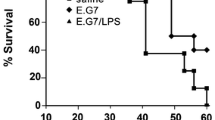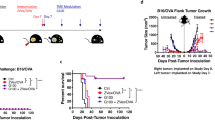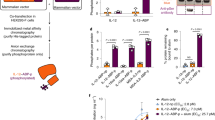Abstract
Lipopolysaccharide fromPantoea Agglomerans (LPSp) has a remarkably high antitumor activity even against poorly immunogeneic tumors when given by intradermal injection combined with cyclophosphamide (CY). We have extended this study to gain an insight into the mechanism of this antitumor effect, and especially into the induction of cell mediated immunity. In immuno-histological studies, extensive necrosis and marked infiltration of the inflammatory cells at the tumor were observed after intradermal injection of LPSp combined with CY, but not after CY alone or after no treatment. The cells around the tumors were mostly neutrophils and macrophages (Mac 1 + ); T cells (CD4 +, CD8 + ) were also present. The serum levels of cytokines, induced after intradermal injection of LPSp, were determined and compared with intravenous administration of LPSp or recombinant TNF-Sam2. TNF-α, IL-1, IL-6 and GM-CSF were measured by ELISA as a marker of cytokine induction. The peak level of TNF-α induced by intradermal injection of LPSp was about 5000 pg ml-1, which was considered relatively small since this level was observed even in clinical trial. There seems to be a longer period of release of TNF-α after an intraderrnal injection than after an intravenous injection. This may produce the remarkably high antitumor effect of the intradermal injection. The antitumor effect of intradermal administration combined with CY was evaluated in nude mice to clarify the role of T cells in high antitumor activity. In this experiment, antitumor activity was found to be much less in BALB/c nu/nu mice without regression, while complete regression was frequently observed in syngeneic mice, show-ing the crucial role of T cells in this treatment. These observations suggest that intradermal administration of LPSp in combination with CY continuously releases and induces not only extensive necrosis of the tumor but also cell mediated antitumor immunity, which may be indispensable for complete regression of the tumor. Clinical application of this treatment for advanced cancer patients is in progress.
Similar content being viewed by others
References
Carlswell, E.A., Old, L.J., Kassel, R.L., Green, S., Fiore, N. and Williamson, B. (1975) An endotoxin-induced serum factor that causes necrosis of tumors.Proc. Natl. Acad. Sci. USA 72, 3666–70.
D’Andrea, A.,. Aste-Amezawa, Valiente, N.M., Ma, X., Kubin, M. and Trinchieri, G. (1993) Interleukin 10 (IL-10) inhibits human lymphocyte interferon γ-production by suppressing natural killer cell stimulatory factor/IL-12 synthesis in accessory cells.J. Exp. Med. 178, 1041–8.
Berendt, M.J., North, R.J. and Kirstein, D. P. (1978) The imrrunological basis of endotoxin-induced tumor regression. Requirement for T-cell mediated immunity.J. Exp. Med. 148, 1550–9.
Nishizawa, T., Inagawa, H., Okutomi, T., Tsukioka, D., Iguchi, M., Soma, G-I and Mizuno, D. (1992) Homeostasis as regulated by activated macrophage. I. Lipopolysaccharide (LPS) from wheat flour: Isolation, purification and some biological activities.Chem. Pharm. Bull. 40, 479–83.
Suma, Y., Goto, S., Kera, J., Sakai, S., Okutomi, H., Soma, G-I. and Takeuchi, S. (1994) Induction of TNF and β- endorphine by oral administration of LPSp and its clinical application.Biotherapy (in Japanese)8, 348–9.
Inagawa, H., Chiba, Y., Nishizawa, T., Okutomi, T., Soma, G-I. and Mizuno, D. Intradermally administered lipopo- lysaccharide stimulates tumor necrosis factor-driven inflammation systemically to cure implanted tumour (Submitted).
Chiba, Y., Inagawa, H., Nishizawa, T., Okuromi, T., Soma, G-I. and Mizuno, D. (1994) Antitumor effect with complete regression by lipopolysaccharide (LPSp) purified fromPantoea agglomerans by intradermal administration.Eur. Cytokine Netw. 5, 231.
Soma, G.-I. and Mizuno, D. (1993) Further developments of the therapy with lipopolysaccharide of a small molecular size on various intractable diseases. A new version of Coley’s toxin. In W. Fiers and W.A. Buurman (eds)Tumor Necrosis Factor: Molecular and Cellular Biology and Clinical Relevance, pp. 203–20. Basel: Karger.
Watanabe, S., Sendo, F., Kimura, S. and Arai, S. (1984) Activation of cytotoxic polymorphonuclear leukocytes byin vivo administration of a streptococcal preparation, OK432.J. Natl. Cancer Inst. 72, 1365–70.
Moriya, Y., Sato, H., Ito, K., Saito, M., Yoshida, T. and Ishida, N. (1993) Induction of antitumor L3T4-positive T cells by OK432 at tumor sites in mice.Cancer Immunol. Immunother. 36, 245–50.
Engelhardt, R., Mackensen, A., Galanos, C. and Andreesen, R. (1990) Biological response to intravenously administered endotoxin in patients with advanced cancer.J. Biol. Resp. Modif. 36, 245–50.
Engelhardt, R., Mackensen, A. and Galanos, C. (1991) Phase I trial of intravenously administered endotoxin (Salmonella abortus equi) in cancer patients.Cancer Res. 51, 2524–30.
Goto, S., Sakai, S., Kera, J., Suma, Y., Soma, G-I. and Takeuchi, S. Intradermal administration of lipopolysaccharide in treatment of human cancer.Cancer Immunol. Immunother.42, 255–61.
Author information
Authors and Affiliations
Rights and permissions
About this article
Cite this article
Iwamoto, I., Goto, S., Kera, J. et al. Mechanistic analysis of high antitumor effect of intradermal administration of lipopolysaccharide fromPantoea Agglomerons . Med Oncol 13, 103–109 (1996). https://doi.org/10.1007/BF02993860
Issue Date:
DOI: https://doi.org/10.1007/BF02993860




